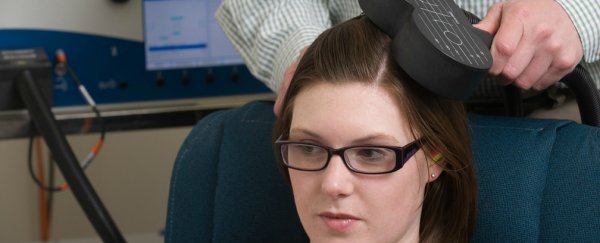Researchers have shown that non-invasive magnetic pulses can reset unhealthy activity in a region of the brain known to be overactive in patients with depression.
The technique is known as transcranial magnetic stimulation (TMS), and has been shown to treat persistent depression, as well as boost people's memories, aid Parkinson's sufferers, and help stroke patients to speak again. But this is the first time researchers have shown exactly how it works on a neurological level, and the results are pretty impressive.
"We found that one session of TMS modifies the connectivity of large-scale brain networks, particularly the right anterior insula, which is a key area in depression," lead scientist Sarina Iwabuchi, from the University of Nottingham in the UK, told the European College of Neuropsychology at a conference in Amsterdam, where the research was presented.
The right anterior insula is part of the prefrontal cortex, and overactivity in the region is linked to excessive rumination, self-absorption and impaired attention in depressed patients. But after delivering powerful magnetic pulses directly to this area in 16 healthy controls and 16 patients with major depressive disorder, the study showed that TMS could slow the activity in this region down in those with depression.
Even better is the fact that TMS is drug-free and painless - the only known side effect is the occasional headache. The technique simply requires a device to be applied to a patient's head. But even though TMS was approved for limited use in the treatment of depression by the US Food and Drug Administration (FDA) in 2008, it's still not widely used.
This is the first study to guide TMS pulses with functional MRI scans, and then measure the changes it produced in the brain, and the results suggest that the treatment may offer a much-needed alternative for the one-third of patients who don't respond to traditional medications such as Lexapro and Prozac.
Currently these patients are recommended to try electroconvulsive therapy (ECT), or electric shock therapy as it's sometimes known, which can be effective but requires anaesthesia and has been associated with side effects such as memory loss. A more targeted form of short electric pulses has been shown to be far gentler, but still requires patients to go under general anaesthetic and several treatment sessions. Scientists also still don't really quite understand how ECT works.
TMS on the other hand doesn't require any medication and appears to begin working after just one session. Importantly, this new study outlines the neurological changes that appear to be driving the positive results.
Of course, there are some big limits to this research, not least of all its small sample size. It also doesn't provide evidence on how long-lasting these neurological changes are. But it's been 30 years since we had a truly new treatment for depression, and so the research provides some much-needed hope for patients and their families.
"These findings are an exciting step in understanding how targeting the brain activity with magnetic stimulation may exert beneficial effects in the treatment of depression," Catherine Harmer, a neuroscientist from the University of Oxford who wasn't involved in the study told Amy Ellis Nutt over at The Washington Post on behalf of the European College of Neuropsychology. "TMS techniques are still evolving … This kind of experimental medicine study is therefore essential for the improved personalisation and treatment of depression in the future."
